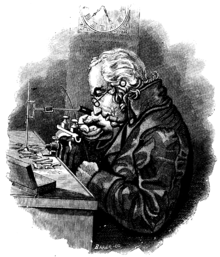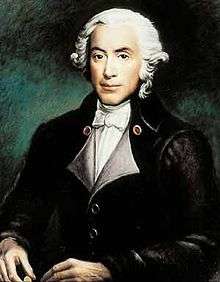Abraham-Louis Perrelet
Abraham-Louis Perrelet, (9 January 1729 – 1826), born in Neuchâtel in Switzerland, was a Swiss horologist.
Abraham-Louis Perrelet | |
|---|---|
 | |
| Born | 9 January 1729 |
| Died | 1826 |
| Occupation | Horologist, Inventor |
Notable work | Automatic watch |
| Parent(s) | Daniel Perrelet |
His father, Daniel was a carpenter and a farmer and as soon as the young man was in a position to do some favours, he helped his parents on the farm. At the age of twenty years he gave up his modest work to learn watchmaking. After an apprenticeship of fifteen days at one named Prince, in Le Locle, who worked little and very badly, and where he learnt absolutely nothing, he started to work independently and so became his own master.[1]
Self-winding watch
About the beginning of 1777, Perrelet invented a self-winding mechanism for automatic watches. It worked on the same principle as a modern wristwatch, and was designed to wind as the owner walked, using an oscillating weight inside the large watch that moved up and down.
The Geneva Society of Arts reported in 1777 that fifteen minutes walking was necessary to wind the watch sufficiently for eight days, and the following year reported that it was selling well.[2] Perrelet is thus widely acknowledged as the inventor of the "automatic" watch. However, his watch probably used a weight pivoting at the side of the movement. The first drawing and accurate description of an automatic watch with a central rotor was created in 1778 by the watchmaker Hubert Sarton (fr:Hubert Sarton) and that design is attributed to him. Following the work of Perrelet, other watchmakers also created automatic watches from about 1777 on.
Breguet
Perrelet sold some of his watches to a contemporary watchmaking luminary, Abraham-Louis Breguet around 1780, who improved upon the mechanism in his own version of the design, calling his watches "perpetuelles", the French word for perpetual.[3][4] They did not work reliably and Breguet stopped producing them around 1810.
Famous grandson

Louis-Frédéric Perrelet (1781–1852), a grandson of Abraham-Louis Perrelet, was trained by his grandfather and went into business in Paris. Louis-Frédéric invented marine watches with measuring instruments and a split-second precision chronograph.[5] He won one of three Lalande awards for 1830.[6][7]
Brand
While the factory claims to have been in continuous production since the late eighteenth century, the brand has only recently begun to command attention worthy of its heritage. The brand, acquired in 2004 by Miguel Rodriguez of the Festina Group, appointed Marc Bernhardt as CEO of Perrelet in 2007, and under his direction the company released a few highly regarded watches. These included watches with retrograde, jumping hour, and double-rotor complications.
In terms of pricing, Bernhardt positioned Perrelet in the lower middle of the luxury market, with most of their releases priced between five and ten thousand (US) dollars. Their upper-range watches featuring costlier complications, such as tourbillons or minute-repeaters, typically retailed in the thirty-forty thousand (US) dollar range.
In 2009 Rodriguez appointed Fausto Salvi as CEO of Perrelet.
References
- Watkins, Richard. "The Origins of Self-Winding Watches, 1773 to 1779". Retrieved 23 November 2016. page 43.
- Watkins, Origins, page 34.
- Watkins, Origins, page 250.
- Watkins, Origins, page 120.
- "Perrelet - Louis-Frédéric Perrelet, Industry News, WorldTempus". Archived from the original on 7 November 2014. Retrieved 17 October 2014.
- "LES LAURÉATS DU PRIX LALANDE". La Revue scientifique. Paris. TOME 40: 460–463. 1887.
- Marlès, Jean Lacroix de (1852). "M. Perrelet a remporté le prix fondé par Lalande ...". Les cent merveilles des sciences et des arts, 2e éd. p. 113.